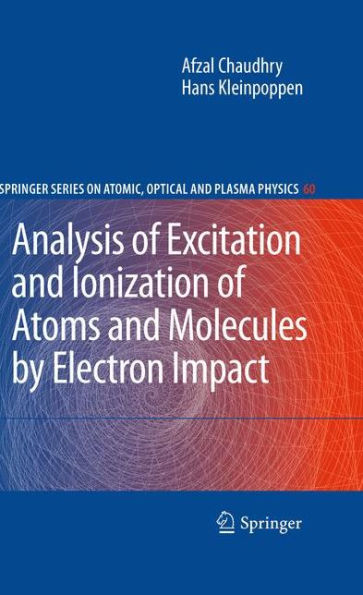Table of Contents
1 Introduction 1
1.1 Ionization of Atomic Gases 1
1.2 Ionization of Hydrogen, Sulphur Dioxide and Sulphur Hexa Fluoride 4
1.3 Excitation of Polarized Sodium and Potassium Atoms 6
1.4 Excitation of Alkaline Earth Metal Atoms of Calcium and Strontium 10
1.4.1 Excitation-Ionization of the Calcium Atom by Electron Impact 11
1.4.2 Measurement of Coherence and Polarization Parameters for the Excitation of the 5 1P State of Strontium 12
1.5 Polarization Correlation Measurements of 3 1P State of Helium 12
1.6 Polarization Correlation Measurements on the 33P State of Helium 13
2 Theoretical Approaches 15
2.1 Ionization Cross Sections of Atomic Gases by Electron Impact 15
2.1.1 Double Differential Cross Sections of Ionization 16
2.1.2 First Born Approximation 16
2.1.3 Plane-Wave Born Approximation 17
2.1.4 Binary Encounter Theory 18
2.1.5 The Inner Shell Ionization 19
2.1.6 Electron Vacancy Transitions of Atoms 20
2.1.7 Characteristic and Continuum X-Rays 24
2.1.8 Close-Coupling Approach to Electron-Impact Ionization 24
2.1.9 Partial Double-Differential Cross Section for Ionization 25
2.2 The Ionization of Hydrogen, Sulphur Dioxide and Sulphur Hexafluoride 26
2.3 Excitation of Spin-Polarized Sodium and Potassium Atoms by Electron Impact 28
2.3.1 Preparation of the State-Selected Na and K Atomic Beams 28
2.3.2 The Collision Induced S-P Excitation 30
2.3.3 Fine and Hyperfine Interaction of the Excited States 33
2.3.4 Polarization of the Fluorescence Radiation 34
3 Apparatus for the electron-atom collision studies 37
3.1 Apparatus for the Electron-Atom Collision Studies 37
3.1.1 The Apparatus for Detecting Photons and Atomic Particles 37
3.1.2 The Vacuum Chamber for Housing the Apparatus 38
3.1.3 The Electron Gun and the Faraday Cup 40
3.1.4 The Atomic/Molecular Beam Source 41
3.1.5 The Electron Analyzer 41
3.1.6 The Ion Analyzer 43
3.1.7 The Negative Ions 45
3.1.8 High-Voltage Power Supplies, Multi-channel Analyzer and Other Electronic Equipment 47
3.1.9 Hyper Pure Germanium (HPGe) X-Ray Detector 47
3.1.10 Energy Structure of Inner Shells, X-Ray Spectra, Augér Effect and Coster-Kronig Transitions 48
3.1.11 Bremsstrahlung X-Rays 63
3.1.12 Crystal X-Ray Spectrometer 68
3.2 The Apparatus for the Electron-Molecule Collision Process 74
3.2.1 The Apparatus and the Electronic Equipment Used in the Experiment 74
3.3 Apparatus for the Study of the Excitation of Spin-Polarized Atoms of Sodium and Potassium 74
3.3.1 Vacuum Chambers for Housing the Apparatus 74
3.3.2 Cancellation of the Earth's Magnetic Field 75
3.3.3 The Components of the Atomic Beam Apparatus 75
3.3.4 Guiding Fields and the Low Field Polarization of Atoms 85
3.3.5 The Rabi Magnet 87
3.3.6 Langmuir-Taylor Detector and the Atomic Beam Density 88
3.3.7 The Electron Beam Components 91
3.3.8 Photon Detection System 96
3.4 Apparatus for the Study of Excitation of Calcium 97
3.4.1 The Vacuum System 97
3.4.2 The Atomic Beam Source 98
3.4.3 Atomic Beam Density 100
3.4.4 The Electron Gun 102
3.5 Apparatus for the Study of Excitation of Strontium 102
3.5.1 The Vacuum Chamber 102
3.5.2 The Atomic Beam Source 102
3.5.3 The Atomic Beam Density 103
3.5.4 The Electron Gun 103
3.5.5 The Electron Energy Analyzer 103
3.6 Apparatus for the Study of Excitation of Helium 104
4 Experimental Techniques 107
4.1 Electron-Ion Coincidence Technique for the Investigation of Multiple Ionization of Atomic Gases 107
4.2 X-Ray-Ion Coincidence Technique 110
4.3 Crystal X-Ray Spectrometer 111
4.4 Experimental Technique for the Investigation of the Ionization of the Molecular Gases 113
4.5 Experimental Technique for the Measurement of the Polarization Parameters of the Induced Fluorescent Radiation in Electron-Polarized Atom Collision Process 117
4.6 The Polarization Parameters of the Fluorescent Radiation 118
4.7 The Corrections for the Measurement of the Polarization of the Fluorescence Radiation 119
4.8 Hanle Effect and the Depolarization of the Fluorescent Radiation 121
4.9 Fine and Hyperfine Structure of Sodium and Potassium Atoms 123
4.10 Hanle Effect Depolarization of the Observed States in Sodium and Potassium Atoms 127
4.11 Experimental Techniques for the Investigation of Electron Impact Excitation of Calcium and Strontium Atoms 130
4.11.1 Experimental Technique for the Study of Excitation of Calcium Atoms 130
4.11.2 Experimental Technique for the Excitation of Strontium Atoms 132
4.12 Experimental Technique for the Study of 3 1P State of Helium 135
4.13 Electron Impact Excitation of 3 3P State of Helium 137
5 Results and Discussion 139
5.1 Measurement of the Ionization Cross Sections for Atomic Gases 139
5.1.1 Helium 140
5.1.2 Argon 141
5.1.3 Krypton 151
5.1.4 Xenon 152
5.1.5 Neon 160
5.1.6 X-Ray-Ion Coincidence Measurements 161
5.1.7 X-Ray Spectroscopy Using a Crystal X-Ray Spectrometer 161
5.2 Measurement of the Ionization Cross Sections for Molecular Gases 162
5.2.1 Hydrogen 162
5.2.2 Sulphur Dioxide 168
5.2.3 Sulphur Hexaflouride (SF6) 181
5.3 Measurements for the Polarization of the Fluorescent Radiation Emitted by Sodium and Potassium Atoms 192
5.3.1 Measurements for the Polarization of the Fluorescent Radiation Emitted by the Sodium Atom 192
5.3.2 Measurements for the Polarization of the Fluorescent Radiation Emitted by the Potassium Atom 197
5.4 The Excitation of Calcium and Strontium Atoms 200
5.4.1 Excitation Function of Ca II Line of Wavelength λ = 393.3 nm 200
5.4.2 Absolute Cross Section for the Ca II 4 2P1/2 State 201
5.4.3 Polarization of the Ca II, λ = 393.3 nm (4 2P3/2← 42S1/2) Transition 202
5.4.4 The Coherence and Polarization Parameter Measurements for the Excitation the 5 1P State in Strontium 203
5.5 Excitation of 3 1P State of Helium 209
5.6 Excitation of 3 3P State of Helium 211
6 Conclusion 217
Bibliography 221
Index 231



